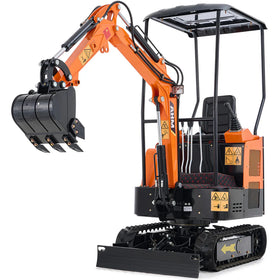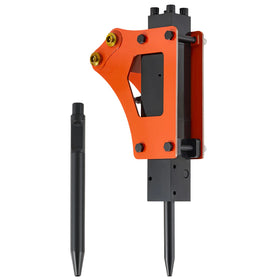The size of your lawn should be the first factor to consider when deciding what size lawn mower is best for your yard.
However, getting the right lawn mower is much more than matching the size of the machine: the "right" mower size isn't just about efficiency - it's about matching the machine to your specific situation. You also have to consider terrain, obstacles, storage space, and how much time you want to spend mowing.
- A 21-inch walk-behind might be perfect for a flat quarter-acre lot, but terrible for a hilly half-acre with lots of trees.
- Meanwhile, that 48-inch riding mower might cut your mowing time in half, but it won't fit through your garden gate.
Here are the top five factors to consider when it comes to deciding what size lawn mower you need.

1. The Size of Your Lawn.
The size of your lawn mower should match the size of your yard. Simply put, the larger your lawn, the wider the cutting deck you’ll need.
While lawn sizes vary by state, the national average yard size in the U.S. is about 10,871 square feet. For a lawn this size, a mower with a 21- to 30-inch cutting width is typically ideal.
If you live in a state like California, where the average yard is just 5,575 sq. ft., a smaller mower may be more practical. On the other hand, in states like Montana, where lawns average around 71,000 sq. ft., you’ll want a larger mower with a 30- to 42-inch deck, or even wider.
Here’s a quick guide to help you choose the right mower based on yard size:
- Small lawns (under ¼ acre): 14–21" cutting width
- Medium lawns (¼ to ½ acre): 21–30" cutting width
- Large lawns (½ to 1 acre): 30–42" cutting width
- Extra-large lawns (1+ acre): 42"+ cutting width
Keep in mind, these are general recommendations. The shape, obstacles, and terrain of your yard also play a big role in determining the best mower size for your needs.
A compact, flat lawn may be manageable with a smaller mower, while hilly or complex layouts may call for something more powerful and maneuverable.
2. Consider the Terrain and Slope
Flat vs. hilly terrain completely changes your mower requirements when it comes to choosing the right lawn mower.
A 42-inch deck that works great on flat ground becomes a scalping nightmare on slopes. Hills require smaller, more maneuverable mowers that can maintain a consistent cutting height.
Here is a simple guideline to help you choose the right lawn mower for different types of terrain.
- Gentle slopes (under 15 degrees): Most mowers handle this fine
- Moderate slopes (15-20 degrees): Need good traction and stability
- Steep slopes (over 20 degrees): Require specialized equipment or walk-behind mowers
3. Obstacles and Tight Spaces
The number of “obstacles” in the yard also plays an important role when it comes to choosing the right lawn mower. A yard with 50 obstacles needs a completely different mower than an open field of the same size
Count your trees, flower beds, and garden features, and anything else that might interrupt the smooth movement of a lawn mower.
Even if you get the right-sized blade, it might become irrelevant if you can't maneuver around your landscaping.
4. Power Source Options
The power source of your lawn mower (gas, electric, or battery) directly affects both performance and maintenance needs of your lawn mower. Choose a power source that fits your yard size, terrain, and how much maintenance you’re willing to handle.
If your yard is large and made of thick grass, a gas-powered lawn mower is probably your best option. They’re best paired with wider cutting decks but require regular maintenance like oil changes and refueling.
If your lawn is small, flat, and relatively level, go for a Corded electric mower. These are usually not great for larger lawns because the length of the power cord limits you.

Consider a battery-powered (cordless electric lawn mower) if your lawn is of medium size. Battery-powered mowers (cordless electric) offer the convenience of gas without emissions or cords.
Gas, electric, or battery power affects both performance and maintenance. Gas mowers typically offer more power for larger cutting widths, while electric and battery models work well for smaller lawns with less demanding cutting requirements.
5. Storage Space
Where will you keep this thing? A 54-inch riding mower with attachments needs serious garage space. Factor in maintenance access, winter storage, and daily convenience when determining size.
Understanding your specific lawn characteristics is crucial for choosing the right mower size and avoiding expensive mistakes.
The average quarter-acre lawn might seem straightforward, but terrain, obstacles, and access points create unique requirements that generic size charts can't address.
Measuring your actual mowing area, identifying challenging sections, and considering seasonal storage needs will ensure that you select equipment that matches your real-world conditions rather than blindly following recommendations.
Recommended Lawn Mower for Big Lawns
For properties over half an acre, you need serious cutting power and efficiency. Traditional push mowers become impractical, and you'll want to consider riding mowers, zero-turn mowers, or robotic solutions.
Big lawn mower recommendations:
- 1/2 to 1 acre: 30-42 inch riding mower or zero-turn
- 1 to 2 acres: 42-48 inch zero-turn or lawn tractor
- 2+ acres: 48+ inch commercial-grade zero-turn or robotic mower
For a ½ acre lawn, you probably need a 30-36-inch riding mower. These typically handle this size efficiently and should be able to complete the job in 45-60 minutes, depending on terrain and obstacles.
The Game-Changer: Remote Control Mowers
Here's where things get interesting. For challenging terrain or large properties, traditional size calculations go out the window. Remote control mowers handle slopes and obstacles that would be dangerous or impossible with conventional equipment.
Why do remote control mowers work for challenging big lawns?
Remote control technology solves the fundamental problems of maintaining large lawns - safety on slopes, precision around obstacles, and operator fatigue.
The AHM LM-55 with its 21-inch cutting width might seem small for bigger properties, but its ability to handle 45-degree slopes and navigate tight spaces remotely makes it incredibly efficient for complex terrain.
The hybrid power system combines a rechargeable 12V battery for quiet operation near the house with a 5 HP 4-stroke engine for power when needed. At 0.25-acre coverage capacity, it's perfect for properties where terrain complexity matters more than raw cutting width.
The zero-turn capability and remote control range of 545 yards mean you can tackle steep hillsides, narrow passages, and obstacle-heavy areas that would require multiple conventional mowers or dangerous manual work.

Key advantages of the AHM LM-55:
- Handles 45-degree slopes - safely mows areas too steep for riding mowers
- 21-inch cutting width - perfect balance of efficiency and maneuverability
- 0.25-acre capacity - ideal for complex terrain up to quarter-acre sections
- Adjustable cutting height - 0.4" to 5" range handles different grass types
- Hybrid power system - quiet battery operation plus gas engine power
- 545-yard remote range - operate from safe distances or the comfort of your deck
For complex big lawns, multiple zones, or steep terrain, the remote control approach often proves more efficient than trying to muscle a massive riding mower through challenging areas.
The Bottom Line: Matching Mower Size to Your Reality
For most quarter-acre properties, a 21-inch self-propelled walk-behind mower hits the sweet spot of efficiency and maneuverability.
For 1/4 acres, it comes down to terrain - flat and open can handle up to 30 inches, while hilly or obstacle-heavy areas work better with 21 inches or remote control options.
For larger properties, consider your most challenging area. If 20% of your lawn is steep or tight, size your mower for those areas and accept longer cutting times on the open sections.
Sometimes the "right" answer is two different mowers - a compact unit for detail work and a larger mower for open areas.
Here is a more detailed guideline with more factors on how to choose the right lawnmower for your yard







